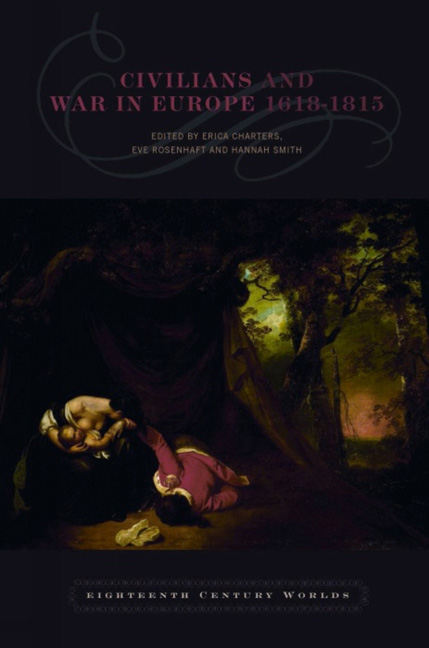Book contents
- Frontmatter
- Contents
- List of Contributors
- Acknowledgements
- List of Illustrations
- List of Abbreviations
- 1 Introduction
- Part I Suffering, Reconciliation and Values in the Seventeenth Century
- Part II The State, Soldiers and Civilians
- 6 The Administration of War and French Prisoners of War in Britain, 1756–1763
- 7 Civilians, the French Army and Military Justice during the Reign of Louis XIV, circa 1640–1715
- 8 Restricted Violence? Military Occupation during the Eighteenth Century
- 9 British Soldiers at Home: The Civilian Experience in Wartime, 1740–1783
- Part III Who is a Civilian? Who is a Soldier?
- Part IV Contradictions of the French Revolutionary and Napoleonic Wars
- Bibliography
- Index
9 - British Soldiers at Home: The Civilian Experience in Wartime, 1740–1783
from Part II - The State, Soldiers and Civilians
- Frontmatter
- Contents
- List of Contributors
- Acknowledgements
- List of Illustrations
- List of Abbreviations
- 1 Introduction
- Part I Suffering, Reconciliation and Values in the Seventeenth Century
- Part II The State, Soldiers and Civilians
- 6 The Administration of War and French Prisoners of War in Britain, 1756–1763
- 7 Civilians, the French Army and Military Justice during the Reign of Louis XIV, circa 1640–1715
- 8 Restricted Violence? Military Occupation during the Eighteenth Century
- 9 British Soldiers at Home: The Civilian Experience in Wartime, 1740–1783
- Part III Who is a Civilian? Who is a Soldier?
- Part IV Contradictions of the French Revolutionary and Napoleonic Wars
- Bibliography
- Index
Summary
HISTORIANS OF previous generations tended to see eighteenth-century European wars before the French Revolution as tame or ‘limited’ affairs, their self-control a conscious reaction to the widespread destruction and brutality of the Thirty Years War (1618–48), which had left much of Germany depopulated and in ruins. To these historians, a key ingredient of the limited nature of eighteenth-century warfare was its minimal impact on civilians in the theatres of operation. Contemporary works on the law of nations, such as the influential Le droit des gens (1758) of the Swiss jurist Emmerich de Vattel, certainly urged the military to show restraint in their dealings with those not in arms against them; a new spirit of proportionality and moderation, so characteristic of the Enlightenment, pervaded his and other writings on the laws of war. Army commanders, older accounts imply, followed the lead of the jurists, and civilians, in return for their not becoming involved in the fighting, were spared the horrors of war. The French Revolution, the same accounts tell us, ended the era of limited war, sweeping away the restraint and decorousness associated with aristocratic control, and restored to armed conflict all its elemental fury.
The idea that the French Revolutionary and Napoleonic wars marked a new beginning, the start of modern ‘total’ conflict, continues to be debated. But the associated notion that earlier eighteenth-century struggles were limited in their impact on non-combatants is no longer fashionable. Modern scholarship has demonstrated beyond any doubt that European wars of that time were highly intrusive affairs and could be truly terrible for civilians unlucky enough to be in the vicinity of the competing armies. Some historians argue that on the eastern fringes of Europe, in wars where the Turks were belligerents, non-combatants who found themselves caught up in military operations suffered particularly badly. The bloody fate of the inhabitants as well as the garrison of Ochakov, on the Black Sea coast, captured by the Russians from the Ottomans in 1788, seems to prove the point, as do other similar incidents in the same war.
- Type
- Chapter
- Information
- Civilians and War in Europe 1618–1815 , pp. 129 - 144Publisher: Liverpool University PressPrint publication year: 2012

